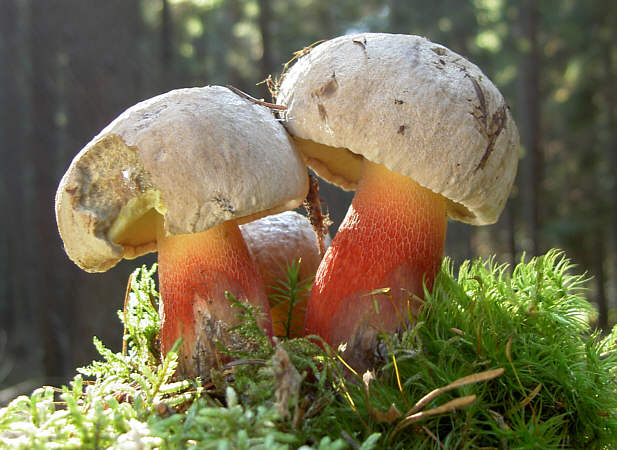- Boletus calopus
Taxobox
name = "Boletus calopus"

image_width = 280px
image_caption = "Boletus calopus"
regnum =Fungi
divisio =Basidiomycota
classis =Agaricomycetes
ordo =Boletales
familia =Boletaceae
genus = "Boletus "
species = "B. calopus"
binomial = "Boletus calopus"
binomial_authority = Pers.mycomorphbox
name = Boletus calopus
whichGills = adnate
capShape = convex
hymeniumType=pores
stipeCharacter=bare
ecologicalType=mycorrhizal
sporePrintColor=olive
howEdible=inedible"Boletus calopus", known as the bitter beech bolete or scarlet-stemmed bolete, is a
fungus of the bolete family, found in Northern Europe and North America. Appearing in coniferous and deciduous woodland in summer and autumn, the fruiting bodies are attractively coloured, with a reddish stem, yellow pores and a beige to olive cap. The bitter-tasting flesh stains blue when broken or bruised and is not edible.Taxonomy
Described by
Christian Hendrik Persoon in 1801, it derives its specific name from the Greek "καλος" ("pretty") and "πους" ("foot"), referring to its brightly coloured stalk. Its German name, [http://de.wikipedia.org/wiki/Sch%C3%B6nfu%C3%9Fr%C3%B6hrling Schönfußröhrling] or 'Pretty-foot bolete' is a literal translation. An alternate common name is scarlet-stemmed bolete.cite book |title=The Great Encyclopedia of Mushrooms |last=Lamaison |first=Jean-Louis |coauthors=Polese, Jean-Marie |year=2005 |publisher=Könemann |isbn=3-8331-1239-5|pages=p. 33]Description
Up to 12 cm (5 in) wide, the cap is beige to olive with yellow pores and an attractive stalk, yellow above to pink-red below. The pale yellow flesh stains blue when broken. Spores are olive to olive-brown. The smell can be strong.
Distribution and habitat
It grows in
coniferous anddeciduous woodland, especially underbeech andoak , on chalky ground from July to December, in Northern Europe and North America'sPacific Northwest andMichigan cite book | author = Phillips R | year = 1991 | title = Mushrooms of North America | publisher = Little, Brown & Co. | id = ISBN] , though the latter appears to be a different subspecies if not a separate species.Toxicity
One Russian author has listed "Boletus calopus" as edible (Vasil’eva, 1978), yet it is regarded by most as at least inedible due to the taste, or even mildly poisonous. The bitter taste does not disappear upon cooking.cite book | author = Carluccio A | year = 2003 | title = The Complete Mushroom Book | publisher = Quadrille | id = ISBN 1-84400-040-0] Though an attractive bolete, it has a very bitter taste and is not considered edible.
References
*Nilsson, S. & Persson, O. (1977) "Fungi of Northern Europe 1: Larger Fungi (Excluding Gill Fungi)". Penguin Books. isbn 0-14-063-005-8
Wikimedia Foundation. 2010.
